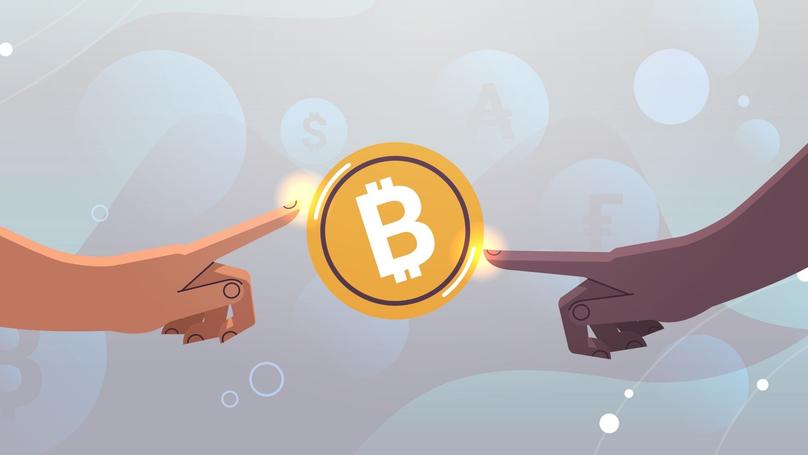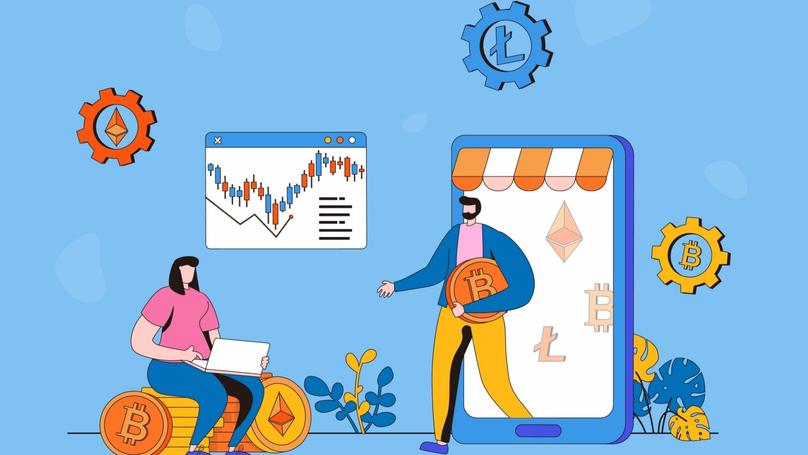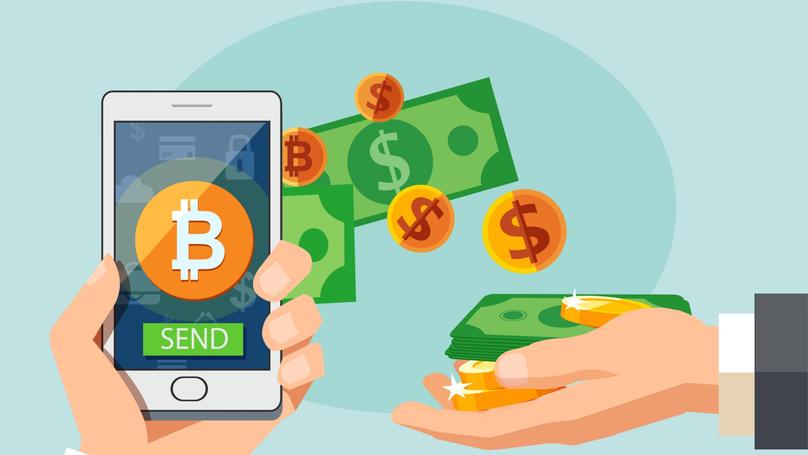Cryptocurrency

What is cryptocurrency?
Cryptocurrency is a form of digital money that lacks a physical form in the shape of coins or banknotes. It exists solely in the online realm. Nevertheless, cryptocurrency can serve purposes similar to traditional money. For instance, it can function as savings, a medium of exchange, or for investment. Crypto has long been accepted by platforms such as eBay and Amazon.
At the same time, the issue of this virtual currency remains beyond the control of any specific state. Additionally, there is no centralised entity that stores information about cryptocurrency transactions. This means it operates decentralised and lacks backing from gold or other precious metals.
The question arises: who creates cryptocurrencies, and how do they come into existence? It's quite straightforward: users themselves create cryptocurrencies. They can be either individuals or entire companies. One of the primary advantages of cryptocurrency over fiat money lies in the transparency and visibility of all ongoing processes. Simply put, interested individuals can readily observe coin transactions on dedicated cryptocurrency platforms. However, no entity, whether banks, tax authorities, or government agencies, can exert influence over this data. Ultimately, all data is stored within the blockchain. We'll tell you more about how this works below.
How does cryptocurrency work?
All information about cryptocurrencies, such as details on coin movement-where they are moving and in what quantities-is stored in specialised registers known as blockchains.
A blockchain is an unbroken, sequential chain of blocks constructed according to specific rules. It contains digital assets, encompassing currency, shares, in-game characters, artwork, and more. Each block of information is interconnected using special keys. If any block is altered or removed, the entire chain becomes compromised. Nevertheless, the probability of such an occurrence is exceedingly minimal. All participants using the blockchain platform manage blocks of information in the blockchain; in other words, individual users manage blocks of information from their own computers, which are connected to each other through the network. To modify or entirely delete even a single block, you must do so across all connected computers rather than just on a single server. This is known as decentralisation.
Therefore, every new transaction involving the transfer or receipt of funds creates a new block in the blockchain. Adding a few zeros to the number of your coins won't alter the blockchain code. All information is protected by cryptography. This is the name for encrypting data using secret keys and several algorithms. For example, to connect the links of a blockchain into each new block, the hash from the previous one is added. The hash is encrypted data about a specific transaction, presented as a unique set of symbols, letters, and numbers.
Furthermore, cryptocurrency can pay for purchases and services, like savings or investments. Nevertheless, the value of cryptocurrency, being unlinked to physical currency, can experience substantial fluctuations due to various factors. These include ongoing political and economic events, influential statements from opinion leaders, and shifts in the stock market. Numerous cryptocurrency holders profit from the continual fluctuations in the value of virtual currency. They buy currency when it becomes cheaper and promptly sell it as soon as it becomes more expensive.
Different types of cryptocurrencies

In the crypto market, various currencies exist, and they can be broadly classified into two groups:
1. Coins
This is a unit of cryptocurrency that has its own blockchain. It is generally obtained through mining, that is, providing a single system with the computing power of your computer. In the context of blockchain platforms, coins represent digital assets. They can be transferred to other users of the same blockchain, sold for regular money, or used for payments. For instance, Microsoft accepts bitcoins as payment for the Windows operating system and the Xbox game console.
2. Tokens
These cryptocurrency units are created and based on existing blockchains. While these coins cannot be independently generated, they can be acquired through individual activities or purchased directly. Likewise, users with the requisite knowledge and skills can create custom tokens on existing blockchains. However, you will need to spend a lot of accumulated coins to do this. Likewise, you must pay commissions for all transactions with tokens, not just their creation. However, tokens, while they cannot be directly used to pay with real money or coins, grant access to additional platform features, allow participation in surveys and voting, and facilitate interactions within decentralised applications. Indeed, coins often hold a higher value than tokens precisely because their creation process is more challenging.
In addition, cryptocurrency is classified in different ways. For example, virtual money is divided into:
-
Coins for payments that can be invested or used to purchase goods (one of the most popular currencies is Bitcoin);
-
Functional coins of certain blockchain platforms, such as Ethereum, which supports smart contracts;
-
Internal tokens of the trading platform are digital currencies from crypto exchanges, which are only issued by them and used to pay exchange fees and transaction commissions (for example, the coin of the largest exchange is Binance Coin);
-
Utility coins are issued in limited quantities to attract investments in certain projects and then used to manage them (for example, tokens of the Uniswap UNI project);
-
Non-fungible tokens, or NFTs, are a separate, unique type of asset. Accordingly, if one bitcoin always equals another, this does not work with NFTs. Works of art and other art objects are created as non-fungible tokens;
-
Stablecoins are tied to a real-life physical asset. They are equal to their value, so they are often used as savings (for example, the world's first stablecoin, USDT, is equal to the dollar's value).
Advantages and disadvantages of cryptocurrencies
It is thought that the key advantage of cryptocurrencies over traditional fiduciary money is the absence of an intermediary - a bank or a state - when making transactions between parties. Hence, the system relies not on trust in government agencies or private commercial organisations but rather on cryptography-a dependable encryption technology. Other advantages include:
-
Confidentiality - Cryptocurrencies maintain complete anonymity. Tracking the sender and recipient of funds is impossible; only crypto wallet numbers are accessible.
-
Open source is the ability to create and mine virtual coins for everyone.
-
Independence from inflation since cryptocurrency is usually issued in limited quantities.
-
Security - Virtual currencies are inherently secure and impervious to hacking, forgery, and other fraudulent schemes. Their robust protection mechanisms ensure reliability. Furthermore, when using cryptocurrencies for payments, the payers' data remains safe across the network, safeguarding it against theft by attackers.
-
Globalism and transnationality - Cryptocurrencies transcend geographical boundaries and operate literally worldwide; they are not subject to restrictions and limits, enabling seamless international transactions.
However, there are also drawbacks. Specifically:
-
Cryptocurrencies remain vulnerable to government bans. Several countries have already imposed restrictions, and violators may incur fines.
-
The inability to cancel or take back a completed payment.
-
Higher volatility, which may lead to potential losses. Cryptocurrency's value is volatile, influenced by demand fluctuations driven by various factors. Therefore, virtual currencies experience value fluctuations.
-
There is a risk of losing money since a unique password is the key to accessing digital coins. If you lose it, the funds in your wallet will be rendered inaccessible.
-
Lack of guarantees - Users bear responsibility for their savings, as no regulatory mechanisms exist.
-
A risk of hacking - Cryptocurrency funds, being electronic, are vulnerable to hacker attacks. While most services and platforms offer robust protection, cybercriminals remain active.
How and where to buy cryptocurrency

Cryptocurrency can be acquired in various ways. One of the simplest is buying it. Here are the three typical stages of this process:
Stage 1. Selecting a platform
There are several ways to purchase cryptocurrency-crypto exchanges, crypto ATMs, payment systems, etc. For beginners, it's best to stick to two traditional options: purchasing crypto at exchange offices or a specialised currency exchange.
The first option entails collaborating with an online platform where, for a typically low commission, you can buy, sell, and exchange cryptocurrencies for traditional currency. NiceChange, ECashExpert, CryptoRoyal and many others provide these services.
The exchange can be found through a special monitoring site like bestchange.com. These sites always have reviews for their services. Opt for the option with the highest number of positive reviews.
There is also a huge variety of cryptocurrency exchanges. These are online platforms for trading cryptocurrency. Sellers and buyers of coins meet there. Each exchange offers different cryptocurrencies, wallet storage, interest rate options, and many more services. Trading takes place in the largest volume on exchanges. For example, Binance is the most popular, but there are others, such as Bybit, OKX, MEXC, Bynex, Garantex, etc.
Payment systems are another intermediary between buyers and sellers. These specialised platforms, some of which specifically handle cryptocurrencies, enable users to buy, sell, and securely store digital assets-for example, Payeer, ADVcash, and Capitalist.
To buy cryptocurrency without intermediaries, consider using P2P exchanges. On these platforms, users can exchange crypto directly with each other. Similar services include Bitpapa, Pexpay, Binance P2P and others. Generally, the commission in Peer-to-Peer exchangers is minimal or non-existent.
Another option for purchasing virtual currency is by using crypto ATMs. These physical ATMs allow you to buy, exchange, or withdraw money. The Coin ATM Radar website provides up-to-date information about all the latest cryptocurrency ATM locations.
Stage 2. Topping up your account
After choosing a platform, you must purchase digital coins directly to top up your account. Most cryptocurrency exchanges enable you to buy virtual currency using real money. For instance, in dollars, euros, and pounds. It is important to pay attention to the commission fees, which often include percentages for depositing and withdrawing funds.
Stage 3. Placing an order
This means an order to purchase cryptocurrency. You can do this through the website or mobile application of your chosen broker, exchange, or exchanger. You should indicate the type of order by selecting the "Buy" option, specify the amount of cryptocurrency you want to purchase, and then confirm. An order to sell digital coins is placed in the same way.
Additional ways to acquire virtual money: how to mine cryptocurrency
Cryptocurrency isn't just purchased; it can also be literally mined. One of the most common methods is mining.
In literal terms, mining refers to the process of extracting minerals. In the crypto industry, this is the name given to the method of producing virtual money using the power of computer equipment. In essence, this process involves user computers worldwide performing intricate calculations to generate new blocks within the blockchain. To add a new block, one must decrypt the cryptographic algorithm or, more straightforwardly, solve a mathematical problem using the computational resources of a computer or cloud server. Accordingly, the greater this power, the faster you can solve the algorithm and earn a reward for it. In simpler terms, miners' work involves selecting the correct hash from millions of symbol combinations.
This method is called Proof-of-Work. It is controlled by a particular regulator, making the task for miners even more complex. Even specialised mining farms have emerged, where individual users pool their efforts and harness the combined power of their equipment to form entire associations of miners. As more miners collaborate to solve a single algorithm, the individual rewards for each miner decrease. This is why mining no longer brings much profit; mining has diminished compared to the early days of the crypto industry.
However, there is also a more passive way to mine coins. This is staking. When staking coins, the computational power of the user's device is not a significant factor. So, if mining income depends on technical equipment, staking relies on the number of available virtual coins. It can be seen as an investment. The owner of the funds voluntarily gives their coins to support the blockchain network's operations, and in return, they receive rewards. When users stake their coins, they effectively store them within the blockchain network. The user thereby ensures its functionality, supports the activity of the network, and increases its security level. This method of mining is called Proof-of-Stake, which is proof of ownership.
Where to store cryptocurrency

After acquiring virtual coins, it's crucial to prioritise their secure storage to safeguard against hacking and theft. To do this, you need a special crypto wallet. These online programs are specifically designed to store private keys for cryptocurrencies securely. It's important to note that the cryptocurrency is not physically contained within such a wallet; rather, it exists on the blockchain. The wallet comprises secret keys that access your cryptocurrency and enable you to transact.
Interestingly, some exchanges provide crypto wallet services, allowing you to store coins on the platform. However, not all platforms support this feature for buying and selling. Therefore, using crypto wallets is the simplest and most reliable approach. They are also different:
-
Custodial
-
Non-custodial.
The former's functionality is akin to that of a bank. A third party, a custodian, will store all information about the wallet owner. Centralised crypto exchanges, exchangers, and custodian services generally issue these wallets directly. To set up a custodial wallet, choose a platform that offers this service and complete the registration process on their website. While it's a quick and straightforward method to create a cryptocurrency wallet, it's not the most secure. If the custodial service falls victim to a hacker attack, your funds could be at risk.
Non-custodial storage provides access to a wallet on the blockchain. Which is also different. For example, "hot" wallets are vaults that use online programs to protect access keys to funds. "hot" wallets include:
-
Desktop - Desktop wallets are software programs installed on a user's computer. They can either store the entire blockchain (which can be hundreds of gigabytes, requiring an external hard drive) or only part of the blockchain;
-
Mobile - These are applications downloaded to the user's phone or tablet, in which keys are stored on the device itself, and information about transactions is stored on third-party resources;
-
Online - These are sites where you can make all the necessary transactions (by the way, online wallets can be both custodial and non-custodial, for example, Guarda).
The point of "hot" storage is that such wallets are always connected to the Internet, and the keys to access the currency are located in programs or your personal account. This can be unsafe because if a virus gets onto your device, attackers can get their hands on users' crypto.
Those depositors and investors who store large amounts of cryptocurrency for a long time prefer "cold" storage for their savings. Unlike hot wallets, these vaults are self-contained electronic devices for more secure storage. "Cold" wallets can be:
-
Hardware - This is a device that can be produced in different formats, for example, as a USB drive with a display, a bank card, and so on. You can purchase them in specialised stores or on marketplaces;
-
Paper - In the form of a printed sheet of paper with a key in QR code format. There are special public keys that can be publicly shown to other users or sent in order for your wallet to be replenished. And there are private keys necessary to confirm transactions. Such a wallet is generated on special websites.
In any case, both types of non-custodial wallets - "hot" and "cold" - are closely interrelated. Thus, it is most convenient to make transactions in a "hot" wallet, and to confirm the operation using hardware or paper.
The most popular cryptocurrencies
By 2024, not just hundreds, but thousands of different currencies will coexist in the crypto universe. Bitcoin is considered the very first in the world and is still the most popular. Back in 2009, it was created by a visionary or even a group of such people, hiding under the pseudonym Satoshi Nakamoto.
These coins are not tied to any assets, and their price depends solely on demand. Anyone can mine bitcoins. Nevertheless, the most important feature inherent in this cryptocurrency is that there cannot be more than 21 million bitcoins. By now, most of the currency has already been mined. It is believed that the last Bitcoin will be mined around 2140. It is the limited emission that is the key advantage of Bitcoin. In addition, its popularity is facilitated by the huge number of ATMs, services, and online markets that accept Bitcoin for payment. For example, there are more than 30,000 of these ATMs installed in the US! And the main disadvantage of Bitcoin lies only in the fact that transactions with this currency are much more expensive and slower than with other coins.
The most popular cryptocurrency after Bitcoin is Ether, created in 2015. The Ether coin is used as a means of payment within the Ethereum blockchain platform, as well as for investment. Its main difference from Bitcoin is the ability not only to perform standard financial transactions, but also to create smart contracts. This is the name for special algorithms that contain the terms of the contract and are intended for automatic control and execution of the terms of the contractual relationship. In simple terms, Ether has the ability to bind an operation to the fulfilment of certain conditions. Ether is popular among crypto miners due to its high profitability at relatively low costs and investments. Additionally, most NFT platforms are built on Ethereum.
One of the most famous cryptocurrencies is the meme Dogecoin, which has the image of a Shiba Inu dog. Since its launch in 2013, the price of Dogecoin has remained relatively stable for several years. The coin's creators, developers Billy Markus and Jackson Palmer, initially intended to mock the cryptocurrency hype. However, their joke gained unexpected traction. Now, Dogecoin is actively used as a means of payment. Entrepreneur and engineer Elon Musk even praised Dogecoin as the best cryptocurrency. He announced that it would be accepted for payment in Tesla stores.
Stablecoin Tether (USDT) became the world's first cryptocurrency pegged to the US dollar. It was launched in 2014 by investor Brock Pierce, developer Craig Sellars and entrepreneur Reeve Collins. It is considered that USDT (Tether) is ideal for long-term fund storage and savings, unlike Bitcoin, which experiences significant price volatility. Therefore, low volatility, as well as rapid speed of execution and transaction confirmation, are Tether's key advantages. One of the drawbacks of Tether (USDT) is its centralisation. The issuing organisation responsible for creating USDT is the management company Tether Limited.
The Binance Coin token was launched in 2017 to trade on one of the largest crypto exchanges in the world-Binance. With this coin, users enjoy fee discounts for various transactions. Now, the token can be exchanged for other currencies, such as Ether or Bitcoin.
Conclusion
Therefore, cryptocurrency has become a revolutionary technology that has literally turned the traditional financial sector upside down, defying critical statements and gaining widespread demand. Its appeal extends beyond entrepreneurs and investors to ordinary users as well. In today's world, digital currencies enable seamless payments for online and offline purchases and investment and fund accumulation. The main advantages of digital money are the confidentiality of transactions, decentralisation and security, high liquidity and various investment opportunities. Furthermore, the barrier to entry into the cryptocurrency industry is more accessible than it may seem. You must familiarise yourself with the basic concepts, choose a platform and start earning money!























